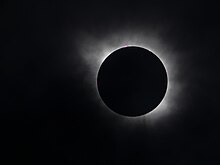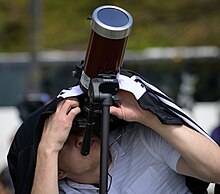


Eclipse photography involves the photographic capturing of solar eclipses and lunar eclipses. This niche field combines elements of astronomy, astrophotography, and sometimes travel photography, as photographers often venture to specific locations to capture these celestial events. Because of the intensity of the sun and the quickly changing conditions, eclipse photography necessitates the use of extremely strong solar filters, usually adhering to the ISO 12312-2 standard.
History
Eclipse photography has a rich history dating back to the 19th century, with advancements in photographic technology and astronomical knowledge significantly impacting its development. The first known photograph of a solar eclipse was taken on July 28, 1851, by Johann Julius Friedrich Berkowski, using the daguerreotype process. [1] [2]
Techniques
Photographers utilize various techniques to capture the different phases of an eclipse, often employing special equipment such as solar filters to protect the camera sensor and the photographer's eyes from the intense sunlight. Long focal lengths and tripods are also commonly used to stabilize the image and capture detailed shots of the celestial event. [3]
Challenges
Eclipse photography presents unique challenges, including the need for precise timing, specialized equipment, and often travel to remote locations. Weather conditions can also significantly impact the ability to capture these events.
Notable photographers
- Fred Espenak - Known as "Mr. Eclipse," Espenak has documented over 20 solar eclipses and provides educational resources on eclipse photography.
- Miloslav Druckmüller - A mathematician and photographer known for his high-resolution images of solar eclipses, which reveal solar corona details usually invisible to the naked eye. [4]
External links
- NASA's Eclipse Photography Guide
- How to Photograph a Solar Eclipse - B&H Photo, April 19, 2023
References
- ^ Weitering, Hanneke (2017-07-28). "1st Photo of a Total Solar Eclipse Was Taken 166 Years Ago Today". Space.com. Retrieved 2024-04-08.
- ^ Farber, Madeline (2017-08-11). "This Is the First-Ever Photo of a Total Solar Eclipse". TIME. Retrieved 2024-04-09.
- ^ Browne, Mathew (2022-04-28). "How to photograph the total solar eclipse today, April 8 2024". Space.com. Retrieved 2024-04-08.
- ^ Cade, D.L. (October 22, 2013). "Striking 13-Photo Composite Captures Two Galaxies and a Comet in the Same Image".



Eclipse photography involves the photographic capturing of solar eclipses and lunar eclipses. This niche field combines elements of astronomy, astrophotography, and sometimes travel photography, as photographers often venture to specific locations to capture these celestial events. Because of the intensity of the sun and the quickly changing conditions, eclipse photography necessitates the use of extremely strong solar filters, usually adhering to the ISO 12312-2 standard.
History
Eclipse photography has a rich history dating back to the 19th century, with advancements in photographic technology and astronomical knowledge significantly impacting its development. The first known photograph of a solar eclipse was taken on July 28, 1851, by Johann Julius Friedrich Berkowski, using the daguerreotype process. [1] [2]
Techniques
Photographers utilize various techniques to capture the different phases of an eclipse, often employing special equipment such as solar filters to protect the camera sensor and the photographer's eyes from the intense sunlight. Long focal lengths and tripods are also commonly used to stabilize the image and capture detailed shots of the celestial event. [3]
Challenges
Eclipse photography presents unique challenges, including the need for precise timing, specialized equipment, and often travel to remote locations. Weather conditions can also significantly impact the ability to capture these events.
Notable photographers
- Fred Espenak - Known as "Mr. Eclipse," Espenak has documented over 20 solar eclipses and provides educational resources on eclipse photography.
- Miloslav Druckmüller - A mathematician and photographer known for his high-resolution images of solar eclipses, which reveal solar corona details usually invisible to the naked eye. [4]
External links
- NASA's Eclipse Photography Guide
- How to Photograph a Solar Eclipse - B&H Photo, April 19, 2023
References
- ^ Weitering, Hanneke (2017-07-28). "1st Photo of a Total Solar Eclipse Was Taken 166 Years Ago Today". Space.com. Retrieved 2024-04-08.
- ^ Farber, Madeline (2017-08-11). "This Is the First-Ever Photo of a Total Solar Eclipse". TIME. Retrieved 2024-04-09.
- ^ Browne, Mathew (2022-04-28). "How to photograph the total solar eclipse today, April 8 2024". Space.com. Retrieved 2024-04-08.
- ^ Cade, D.L. (October 22, 2013). "Striking 13-Photo Composite Captures Two Galaxies and a Comet in the Same Image".